16 August 2024 : Daily Current Affairs
1. Digital platform driven by drone mapping to revive solar power scheme
(Source – The Hindu, International Edition – Page No. – 1)
| Topic: GS2 – Governance – Digital Governance |
| Context |
|
Introduction to PM-KUSUM and Its Objectives

- The Pradhan Mantri-Kisan Urja Suraksha evam Utthaan Mahabhiyan (PM-KUSUM) scheme was launched to bolster solar energy infrastructure in agriculture, aiming to set up 100 GW of solar power plants on farmer-owned land, install 14 lakh solar pumps, and solarise 35 lakh grid-connected agricultural pumps.
- As of June 2024, progress has been slow, with only 256 MW of power plants, 3.97 lakh solar pumps, and 13,500 solarised pumps installed, leading to a deadline extension to 2026.
Challenges in Implementation
- A major challenge is the unavailability of suitable land for solar power projects, particularly in agricultural regions where finding contiguous parcels of land is difficult.
- Unlike states like Gujarat and Rajasthan, which have vast tracts of uncultivable land, agricultural areas struggle to pool together land for large-scale solar projects.
Innovative Approaches: Drone Technology and Digital Platforms
- Global Energy Alliance for People and Planet (GEAPP) is collaborating with the Rajasthan government to develop a digital platform that uses drone technology to map land parcels, enhancing the efficiency of land identification for solar projects.
- This digital approach allows real-time tracking of the scheme’s progress, enabling prompt corrective actions and providing oversight critical for large-scale solar deployment.
Success in Rajasthan and Future Plans
- Rajasthan has emerged as a leader in the PM-KUSUM scheme, with 12.3 MW of solar capacity already installed and plans to reach 100 MW by 2024.
- Farmers who lease their land for solar modules receive rent payments linked to market rates, ensuring fair compensation.
Conclusion
- Rajasthan has installed nearly 200 MW of the 256 MW installed nationally, setting an example for other states.
- The use of digital solutions and on-ground support by GEAPP is pivotal in overcoming challenges and achieving renewable energy targets under the PM-KUSUM scheme.
| PM-KUSUM |
|
| Practice Question: Evaluate the challenges faced in the implementation of the PM-KUSUM scheme and discuss the innovative solutions being adopted to address these issues. (150 Words /10 marks) |
2. Dengue control: the unrealised promise of Wolbachia-infected mosquitoes
(Source – The Hindu, International Edition – Page No. – 7)
| Topic: GS2 – Social Justice – Health |
| Context |
|
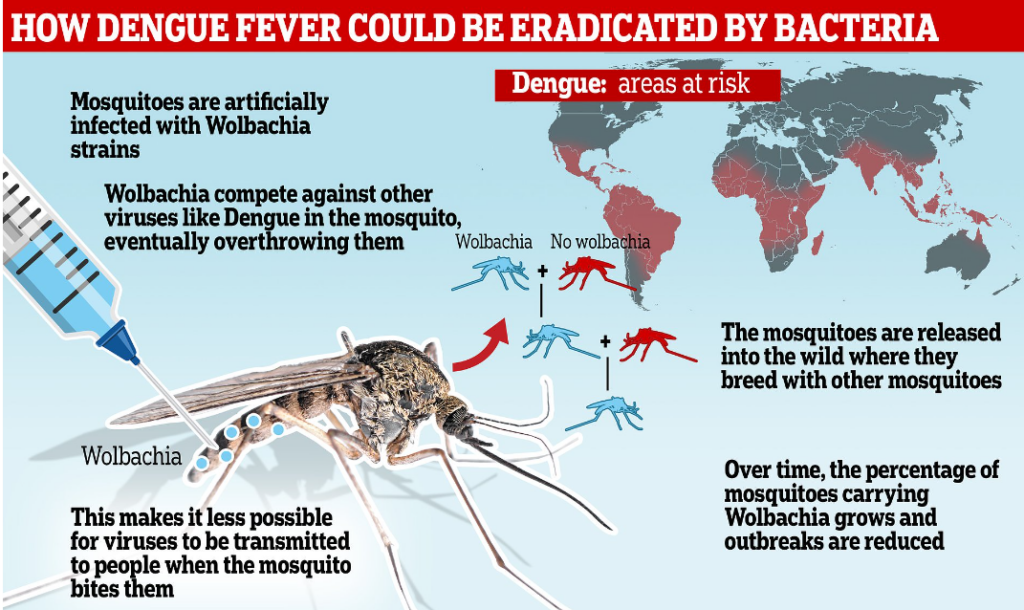
Dengue’s Economic and Health Impact
- Economic Burden: Dengue imposes a significant economic burden in India, estimated at around ₹28,300 crore annually in direct costs.
- The disease leads to the loss of approximately 5.68 lakh years of young life each year.
Current Vector Control Strategies
- Modest Success: Existing methods, including insecticides and community education, have seen limited success.
- Vaccine and Antiviral Agents: Clinical trials are ongoing for dengue vaccines, and effective antiviral agents remain undiscovered.
Innovative Vector Control Methods
- Wolbachia Bacterium: Studied globally since 2009, Wolbachia, a bacterium found in many insects but not Aedes mosquitoes, shows promise.
- Dual Relationship: Wolbachia exhibits mutualism by providing viral resistance and parasitism by reducing the insect’s lifespan and skewing populations towards females.
| More About Wolbachia Bacterium: |
|
Field Trials and Strategies
- Australia’s Approach: Used the wMel strain to promote viral resistance without shortening mosquito lifespan, leading to successful population replacement and near dengue elimination.
- Singapore’s Approach: Implemented population suppression by releasing Wolbachia-infected males, reducing Aedes populations by 90% and dengue cases by 77%.
- Indonesia Trial: A landmark trial showed a 77% reduction in dengue cases and an 86% reduction in hospitalizations in areas with wMel mosquito releases.
wMel Programs in India
- Current Status: India has no active wMel release program. ICMR-VCRC is developing wMel Aedes strains and has reported finding Wolbachia naturally in Aedes in North East India.
- Potential Benefits: The wMel strategy could reduce the burden of dengue, chikungunya, Zika, and other emerging infections, proving highly cost-effective.
Recommendations
- Public Messaging: Effective communication about mosquito releases is crucial.
- Learning from Global Experiences: Insights from other countries’ mosquito release programs can guide implementation in India.
- Urgency: Reducing mosquito-borne illnesses is vital to alleviate healthcare system strain and enhance productivity. Funding and exploring innovative vector control methods are essential to combat the triple threat of dengue, chikungunya, and Zika.
| Practice Question: Discuss the potential benefits and challenges of implementing the Wolbachia-based mosquito control strategy in India for managing dengue and other mosquito-borne diseases. How could this approach impact the current vector control efforts? (150 Words /10 marks) |
3. How can traffic which causes air pollution be controlled?
(Source – The Hindu, International Edition – Page No. – 10)
| Topic: GS3 – Environment – Environment pollution and degradation |
| Context |
|
Severity of Air Pollution in India
- A recent report highlighted that India is home to 83 of the 100 most polluted cities in the world.
- Another report from the British Medical Journal estimated that air pollution led to the deaths of 2.1 million people in India, second only to China.
- Over 99% of the Indian population breathes air that is poorer than the recommended WHO standards.
Impact of Road Transport on Air Pollution
- The International Energy Associates estimated that 12% of India’s CO2 emissions are due to road transport, with heavy vehicles being a major contributor.
- Heavy vehicles are responsible for the majority of Particulate Matter (PM) 2.5 emissions, which can cause severe respiratory and cardiovascular effects.
- They also contribute significantly to the emission of Nitrogen Oxide (NOx), which worsens air quality and increases the formation of ground-level ozone.
Measures Taken to Combat Air Pollution
- The Bureau of Energy Efficiency (BEE) has developed Corporate Average Fuel Economy (CAFE) norms for cars, with CAFE III to be implemented from 2027-2032 and CAFE IV from 2032-2037.
- The shift to the World Light Duty Vehicle Testing Procedure (WLTP) by 2027 is expected to provide a more accurate measure of vehicle emissions.
- However, CAFE norms exclude emissions from heavy vehicles like trucks and lorries.
Suggestions for Improvement
- The vehicle scrappage policy introduced in 2022 aims to phase out old and polluting vehicles but is yet to take off effectively in states like Karnataka due to limited scrapyards and the voluntary nature of the policy.
- Maharashtra has offered incentives to encourage vehicle scrapping, but this has had limited impact on air pollution.
- Stringent implementation of existing policies, such as regular vehicle emission tests, banning open garbage burning, and checking industrial emissions, is necessary.
- Mass transit offers a sustainable approach to reducing air pollution and mitigating its adverse health effects in India.

| PYQ: Mumbai, Delhi and Kolkata are the three megacities of the country but the air pollution is a much more serious problem in Delhi as compared to the other two. Why is this so? (200 words/12.5m) (UPSC CSE (M) GS-1 2015) |
| Practice Question: Examine the effectiveness of India’s current policies in combating air pollution, particularly in urban areas. Discuss the role of road transport and suggest sustainable measures to address the challenge. (250 Words /15 marks) |
4. WHO Declares Mpox a Global Health Emergency Again Amid Rising Cases in Africa
(Source: Indian Express; Section: Explained; Page: 07)
| Topic: GS2 – Social Justice – Health GS3 – Science and Technology |
| Context: |
|
Analysis of News:
What are Zoonotic diseases?
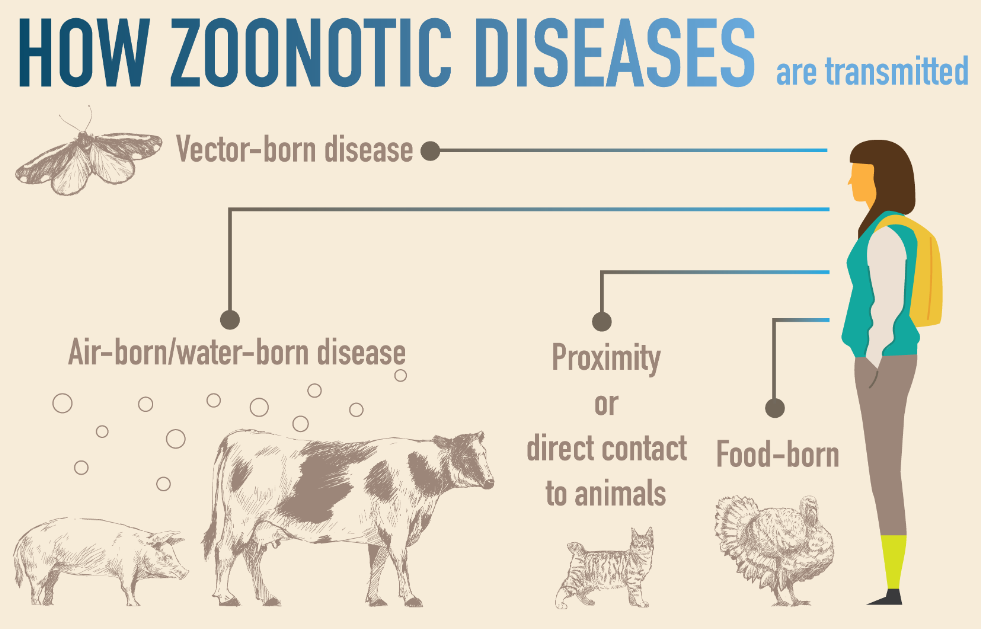
- These are infections that are spread between people and animals.
- These infections are caused by germs, such as viruses, bacteria, parasites, and fungi.
- Some can be severe and life-threatening, such as rabies, and others may be milder and get better on their own.
What is Mpox?
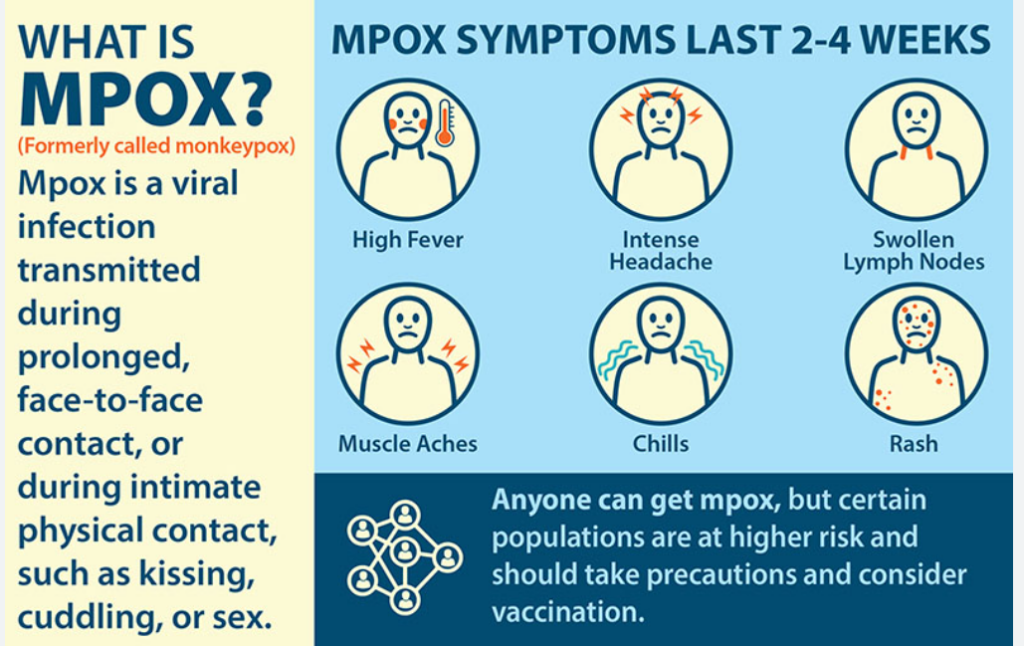
- Mpox is a viral infection caused by the mpox virus (MPXV), characterized by symptoms such as fever, headache, muscle aches, and pox-like rashes.
- Although usually self-limiting, it can be fatal in vulnerable populations, particularly children and those with weakened immune systems.
- Historically confined to Africa, the infection has recently spread globally.
Current Concerns
- The main concern arises from the spread of a more virulent strain of the virus, clade Ib, which is now being transmitted primarily through sexual contact—a departure from the traditional zoonotic transmission observed with other mpox clades.
- Over 100 cases of clade Ib have been reported in countries neighboring the DRC, indicating a worrying trend that requires a coordinated international response.
Global and Indian Risks
- The rapid spread of this new clade has led to global concerns, with cases reported outside Africa, including Sweden.
- India, which saw cases during the 2022 outbreak, remains at risk, especially with international travel being a factor in spreading the virus.
- WHO has highlighted the need for urgent action to prevent a repeat of the global outbreak seen in 2022.
Vaccine Availability
- There are two vaccines currently recommended by WHO for mpox.
- WHO’s recent Emergency Use Listing for these vaccines aims to improve access, particularly in lower-income countries.
- Efforts are ongoing to coordinate vaccine distribution and ensure equitable access globally.
- India has also been involved in manufacturing vaccines and diagnostics in response to the previous outbreak.
| Difference Between Small Pox, Chicken Pox, Mpox |
 |
| PYQ: Critically examine the role of WHO in providing global health security during the Covid-19 pandemic. (150 words/10m) (UPSC CSE (M) GS-2 2020) |
| Practice Question: Discuss the global implications of the recent mpox (monkeypox) outbreak, especially in the context of its declaration as a Public Health Emergency of International Concern (PHEIC) by the World Health Organization. How should international and national health systems, including India, prepare to address such emerging health threats? (250 words/15 m) |
5. Retail Food Inflation Drops Sharply to 5.4% in July, But Uncertainty Persists
(Source: Indian Express; Section: Explained; Page: 07)
| Topic: GS3 – Indian Economy |
| Context: |
| Retail food inflation dropped to 5.4% in July 2024 from 9.4% in June, primarily due to a high base effect from July 2023. |
Analysis of News:

What is Inflation?
- Inflation refers to the overall increase in the prices of goods and services, coupled with a decrease in people’s purchasing power.
- This means that when inflation rises (without an equivalent rise in your income), you are able to buy fewer things than you could buy previously, or you have to pay more money for the same stuff now.
- A “rising” inflation rate implies that the rate (at which the prices rise) itself is increasing.
- For example, if the inflation rate was 1% in March, 2% in April, 4% in May, and 7% in June, it shows a continuous acceleration in the rate of price increases.
What are the Different Indices through Which Food Inflation is Measured in India?
- Consumer Price Index (CPI):
- CPI inflation, also known as retail inflation, is the rate at which the prices of goods and services that consumers buy for personal use increase over time.
- It measures the change in the cost of a basket of goods and services that are typically purchased by households, including food, clothing, housing, transportation, and medical care, and are of four types:
- CPI for Industrial Workers (IW).
- CPI for Agricultural Labourer (AL).
- CPI for Rural Labourer (RL).
- CPI for Urban Non-Manual Employees (UNME).
- Consumer Food Price Inflation (CFPI):
- CFPI is a component of the broader Consumer Price Index (CPI), where the Reserve Bank of India (RBI) utilises the CPI-Combined (CPI-C) for this purpose.
- CFPI monitors the price fluctuations of a particular selection of food items commonly consumed by households, including cereals, vegetables, fruits, dairy products, meat, and other essential food staples.
- CFPI is a component of the broader Consumer Price Index (CPI), where the Reserve Bank of India (RBI) utilises the CPI-Combined (CPI-C) for this purpose.
- The Wholesale Price Index (WPI):
- It tracks changes in the prices of goods sold and traded in bulk by wholesale businesses to other businesses and it specifically focuses on goods, services are not part of it.
- The WPI is utilized to monitor supply and demand dynamics in industries, manufacturing, and construction sectors.
- Released monthly by the Economic Advisor in the Ministry of Commerce and Industry, the index measures the level of wholesale inflation in the economy based on the month-to-month increase in WPI, and it comprises various component
- Primary articles, constituting 22.62% of the Wholesale Price Index (WPI), are divided into Food Articles and Non-Food Articles.
- Food Articles encompass items like Cereals, Paddy, Wheat, Pulses, Vegetables, Fruits, Milk, Eggs, Meat, and Fish.
- Non-Food Articles include Oil Seeds, Minerals, and Crude Petroleum.
- Impact on Economy: Despite the decline, food inflation remains a significant concern, limiting household spending and preventing the Reserve Bank of India from reducing interest rates.
- Monsoon Influence: The southwest monsoon revived after a weak start in June, leading to above-normal rainfall in July and August. This improved water availability has led to increased acreage for key crops like rice, pulses, maize, oilseeds, and sugarcane.
- Global Food Prices: Global food prices have decreased since December 2022, helping to mitigate domestic inflation. Lower international prices for commodities like wheat make imports more feasible, potentially easing domestic prices.
- Cautious Optimism: While the good monsoon and potential La Niña conditions are positive, the full impact on food inflation will only be clear after the upcoming harvests. Uncertainty remains, especially with the harvest still weeks away.
| What are the Strategies that Need to be Adopted to Tackle Food Inflation in India? |
|
Improved Supply Chain Management:
Agricultural Productivity Enhancement:
Price Monitoring and Regulation:
Agricultural Diversification:
Climate Resilience:
Utilizing technology:
|
| PYQ: There is also a point of view that agriculture produce market committees (APMCs) set up under the state acts have not only impeded the development of agriculture but also have been the cause of food inflation in India. Critically examine. (200 words/12.5m) (UPSC CSE (M) GS-3 2014) |
| Practice Question: Examine the recent trends in retail food inflation in India and discuss the factors influencing it. How can government policies mitigate the impact of food inflation on the economy and households? (250 words/15 m) |
6. Prime Minister Narendra Modi Pays Tribute to Sri Aurobindo on His Birth Anniversary
(Source – https://pib.gov.in/PressReleseDetail.aspx?PRID=2045529 )
| Topic: GS1 – Modern Indian History – Personalities |
| Context |
|

More About Aurobindo Ghosh:
- Early Life: Born on August 15, 1872, in Kolkata, Aurobindo Ghosh was educated in England, where he attended King’s College, Cambridge.
- Freedom Struggle: Initially involved in the Indian independence movement, Aurobindo played a significant role in revolutionary activities, advocating for complete independence from British rule.
- Alipore Bomb Case: Arrested in 1908 due to his involvement in the Alipore Bomb Case, Aurobindo was acquitted after a year-long trial.
- Spiritual Turn: Post his acquittal, Aurobindo withdrew from active politics and moved to Pondicherry in 1910, where he delved deeply into spiritual practices.
- Integral Yoga: Developed the concept of Integral Yoga, aiming for the evolution of human consciousness and the realisation of a divine life on earth.
- Aurobindo Ashram: Founded the Aurobindo Ashram in 1926, which became a centre for spiritual seekers.
- Literary Contributions: Authored numerous philosophical and spiritual works, including The Life Divine and Savitri.
- Legacy: Passed away on December 5, 1950; his teachings continue to inspire spiritual and philosophical thought globally.
| Practice Question: Discuss the role of Aurobindo Ghosh in the Indian freedom struggle and analyse how his shift towards spirituality influenced his vision for India’s future. (150 Words /10 marks) |
Prelims Facts
1. Indian astronomers find new method to predict amplitude of next solar cycle
(Source – The Hindu, International Edition – Page No. – 3)
| Context |
|
Analysis of the news:
- Astronomers from the Indian Institute of Astrophysics (IIA) have developed a new method to predict solar cycle amplitude and improve space weather forecasting.
- Their research, based on 100 years of solar data from the Kodaikanal Solar Observatory, reveals a new correlation.
- Space weather, influenced by solar wind, coronal mass ejections, and solar flares, can impact Earth’s magnetosphere, affecting communications, power systems, spacecraft, and astronauts’ safety.
- Forecasting methods include theoretical calculations, dynamo models, and precursor methods.
- The precursor method uses solar activity measures to predict the strength of future solar maxima.
- IIA researchers found that the width of supergranular cells on the solar surface during a solar minimum is related to the number of sunspots in the next solar maximum, providing a new forecasting tool.
| What is a solar cycle? |
|
2. Centre launches new AI-based surveillance system to manage pests
(Source – The Hindu, International Edition – Page No. – 6)
| Context |
|
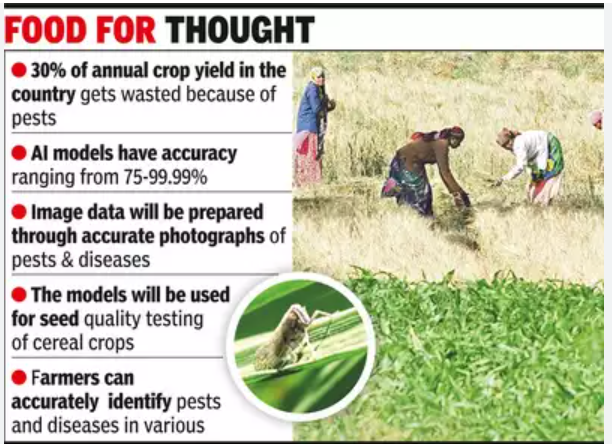
Analysis of the news:
- The National Pest Surveillance System (NPSS) was launched by the Union government to assist farmers in pest management using artificial intelligence (AI).
- The system allows farmers to connect with agriculture scientists and experts via mobile phones for pest control.
- Agriculture Minister Shivraj Singh Chouhan emphasised that the NPSS aims to reduce farmers’ reliance on pesticide retailers and promote a scientific approach to pest management.
- NPSS analyses real-time data with AI tools to assist in identifying and managing pests.
- It enables farmers to send photos of infested crops or insects directly to scientists for expert advice.
- The system aims to help about 14 crore farmers across India by providing timely and accurate solutions for pest control.
- The NPSS also addresses the issue of excessive pesticide use, promoting correct application at the right time.
- The system has undergone successful pilot trials and will be propagated to States for further outreach and implementation.
3. Study Reveals Critical Aging Milestones at Ages 44 and 60, Offering New Health Insights
(Source: Indian Express; Section: Explained; Page: 07)
| Context: |
|
Analysis of News:
- Study Details: The research, involving 108 participants aged 25-75, tracked cellular changes over 1.7 years. Key findings include shifts in immune regulation and carbohydrate metabolism at 60, and changes linked to cardiovascular health at 44.
- Implications: These insights could lead to targeted lifestyle changes to mitigate aging effects. The study emphasizes understanding aging processes for better healthspan, not just lifespan.
- Limitations: The study had a small sample size, short duration, and limited geographic scope. The exact causes of the observed changes remain unknown, leaving room for further research to identify potential interventions.
4. Stonehenge’s Altar Stone Traced to Scotland, Revealing New Insights into Neolithic Britain
(Source: Indian Express; Section: Explained; Page: 07)
| Context: |
| Stonehenge remains one of the greatest marvels of Neolithic engineering, with unresolved questions about its purpose, construction, and origins. |
Analysis of News:
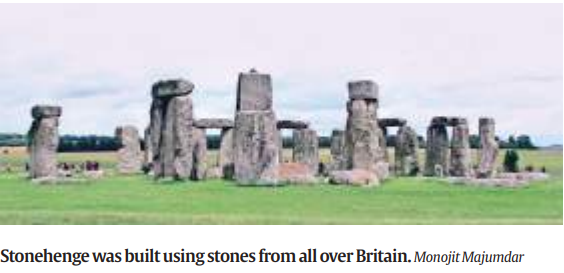
- Altar Stone’s Origin: Recent geochemical analysis reveals that the six-ton Altar Stone likely originated from the Orcadian Basin in northeast Scotland, approximately 800 km from Stonehenge, rather than from Wales as previously thought.
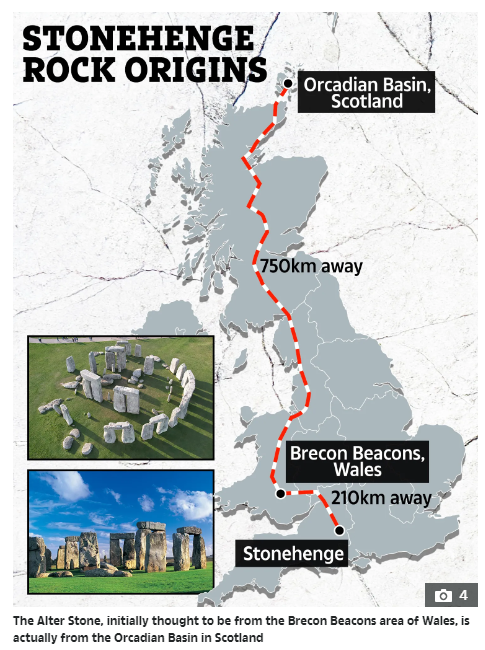
- Transportation Theories: Experts believe the stone was transported to Salisbury Plain by human effort, possibly via sea or an overland journey. This suggests greater social integration in Neolithic Britain than previously understood.
- Implications: The discovery challenges existing notions about prehistoric Britain’s social and cultural complexity, highlighting the sophisticated networks and the significance attributed to such monumental undertakings.
5. Police Seize Suspicious Substance Believed to Be Californium, Later Found to Be Non-Radioactive
(Source: Indian Express; Section: The Cover Page; Page: 01)
| Context: |
|
Analysis of News:
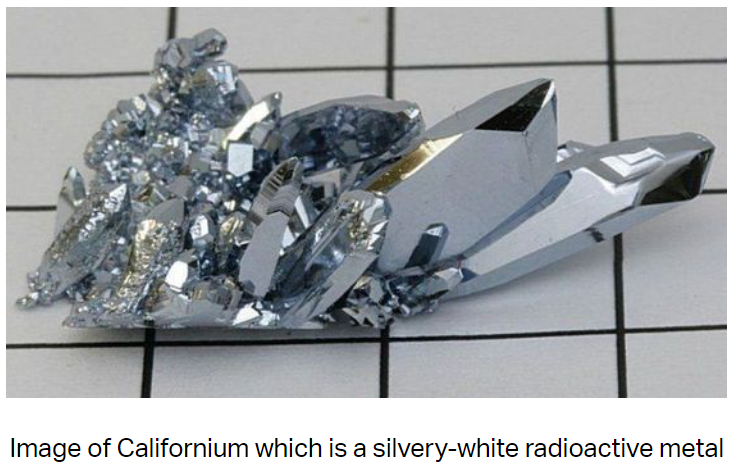
Californium is a synthetic, highly radioactive metal with the atomic number 98 on the periodic table. It was first produced in 1950 at the University of California, Berkeley, from which it gets its name. Californium is part of the actinide series and is one of the heaviest elements that can be synthesized.
Key Characteristics:
- Appearance: Silvery-white metal.
- Radioactivity: Californium is highly radioactive and is a potent neutron emitter. It has a half-life of about 2.6 years for its most stable isotope, Californium-252.
- Production: It is produced in nuclear reactors and particle accelerators by bombarding curium (another radioactive element) with neutrons.
- Cost: Californium is extremely expensive, with a cost of around Rs 17 crore (approximately $2 million) per gram in the international market.
Uses:
- Neutron Source: Due to its strong neutron emission, Californium is used in neutron radiography, a technique for inspecting materials, particularly in detecting metal fatigue in aircraft.
- Medical Applications: It is used in certain cancer treatments where targeted neutron therapy is required.
- Scientific Research: It is used in nuclear research to help study the properties of other elements and materials.
- Oil and Gas Exploration: Californium is used in portable neutron sources to help identify layers of water and oil in wells.
Safety and Handling:
- Hazards: Because it is highly radioactive, handling Californium requires specialized equipment and strict safety protocols to prevent radiation exposure.





